Lithium indium diselenide (LISe) is a newly discovered I-III-VI semiconductor (sc-LISe) and scintilator (s-LISe) that is highly sensitive to thermal neutrons when enriched in lithium-6. This novel material has opened the door for the development of new, direct conversion thermal and fast neutron sensing technologies. Our group is focusing on the understanding the basic electronic and radiation sensing properties of LISe in support of the development of thermal and fast neutron imaging sensors. The high lithium-6 content enables the use of thin samples for efficient thermal neutron detection in both semiconductor and scintllator modes of operation. This project is supported through a subcontract with CNS Y-12 National Security Complex.
The basic semiconducting properties of LISe are still not well-characterized. Fundamental semiconducting properties such as the charge carrier mobility, trapping time constant, and lithium drift are all important to the absolute efficacy of LISe for certain applications. These parameters are directly indicative of the charge collection efficiency of the crystal as well as its long-term stability as a neutron sensor. Furthermore, as a semiconductor radiation detector, the development of a robust, Ohmic contact that withstands packaging (e.g. wire bonding) and maintains long-term adhesion. Our efforts in detector development and characterization of LISe serves to provide feedback to the crystal grower collaborators at CNS Y-12 and Fisk University as well as map out its potential application space.
 LISe provides the possibility of high detection efficiency, high rate, and gamma-ray rejection-capable sensor required for neutron imaging applications. Our research is focused on development of low and high channel density neutron imaging sensors utilizing LISe. Our 16 channel imager is shown in the picture on the right, where we designed the electronics circuit boards and patterned and packaged the LISe sensor in-house. This imager was successfully demonstrated at the High Flux Isotope Reactor (HFIR) CG-1D beam line at Oak Ridge National Laboratory (ORNL). Associated experiments include LISe crystal semiconductor and detector characterization to identify important crystal defect types to aid in optimizing LISe crystal growth. Our current efforts are focused on coupling LISe to a high density channel ASIC to overcome the combined dynamic range, gamma-ray rejection, detector efficiency, detector speed, and spatial resolution limitations of current commercial neutron imaging sensor systems. Often, when one of these are increased, another is decreased. LISe’s semiconducting properties over other neutron sensing materials provides the possibility of increasing the spatial resolution while maintaining the optimum performance in these other critical system performance metrics.
LISe provides the possibility of high detection efficiency, high rate, and gamma-ray rejection-capable sensor required for neutron imaging applications. Our research is focused on development of low and high channel density neutron imaging sensors utilizing LISe. Our 16 channel imager is shown in the picture on the right, where we designed the electronics circuit boards and patterned and packaged the LISe sensor in-house. This imager was successfully demonstrated at the High Flux Isotope Reactor (HFIR) CG-1D beam line at Oak Ridge National Laboratory (ORNL). Associated experiments include LISe crystal semiconductor and detector characterization to identify important crystal defect types to aid in optimizing LISe crystal growth. Our current efforts are focused on coupling LISe to a high density channel ASIC to overcome the combined dynamic range, gamma-ray rejection, detector efficiency, detector speed, and spatial resolution limitations of current commercial neutron imaging sensor systems. Often, when one of these are increased, another is decreased. LISe’s semiconducting properties over other neutron sensing materials provides the possibility of increasing the spatial resolution while maintaining the optimum performance in these other critical system performance metrics.
 The optical clarity of s-LISe allows highly efficient neutron converter in neutron transmission imaging sensors, where light scattering and diffusion in opuque, polycrystalline materials like ZnS(Cu):LiF neutron converters is not a fundamental limitation. Through research conducted at the CG-1D Neutron Imaging Facility at the High Flux Isotope Reactor at Oak Ridge National Laboratory, we have experimentally demonstrated many important quantities. First, we have shown that the lithium-6 concentration and scintillation yield is very uniform within the majority of samples tested. More importantly, we have shown that the resolution capabilities of s-LISe approach the resolution of the CCD Nyquist frequency, far beyond that achievable with a 50 um thick ZnS(Cu):LiF scintillation screen.
The optical clarity of s-LISe allows highly efficient neutron converter in neutron transmission imaging sensors, where light scattering and diffusion in opuque, polycrystalline materials like ZnS(Cu):LiF neutron converters is not a fundamental limitation. Through research conducted at the CG-1D Neutron Imaging Facility at the High Flux Isotope Reactor at Oak Ridge National Laboratory, we have experimentally demonstrated many important quantities. First, we have shown that the lithium-6 concentration and scintillation yield is very uniform within the majority of samples tested. More importantly, we have shown that the resolution capabilities of s-LISe approach the resolution of the CCD Nyquist frequency, far beyond that achievable with a 50 um thick ZnS(Cu):LiF scintillation screen.
The image shown is the comparison of s-LISe versus the ZnS(Cu):LiF scintillation screen. The image displayed shows that s-LISe, which was more than ten times as thick as the ZnS(Cu):LiF scintillation screen produced a slightly better visual spatial resolution. However, a knife-edge test indicates a capable spatial resolution greater than this by about a factor of four. The difference in these two results can be explained by the fact that the same optical setup was used for each scintillation screen. Using appropriately designed optics, the necessary contrast should be achievable to provide visual evidence to support the knife-edge test results.

The development of a high resolution neutron imager is sought through the investigation of the growth of single crystal, semiconducting boron carbide on a suitable substrate. Chemical vapor deposition techniques are utilized to deposit the boron carbide films. To provide a high spatial resolution for a neutron imager based upon the thermal neutron capture by B-10, novel columnar formations are considered using patterned growth substrates and post-process etching to limit signal and charge sharing between pixels beyond the limit imposed by the range of the secondary particles. This project is supported by NSF Communications, Circuits, and Sensing Systems, grant number 1307759.
The radiation tolerance of the inner tracking charged particle detectors of ATLAS and CMS at CERN receive a large fluence over their lifetime. Current plans to upgrade the facility for higher luminosity experiments require an even higher radiation tolerance. Current silicon planar detectors are not able to survive the expected fluences. The larger binding energy of 42 eV of diamond provides a higher radiation tolerance over silicon, and in diamond there is no need to create a pn junction for radiation detection, but operates as a resistive device. In a 3D geometry, column electrodes are created in the diamond substrate to provide a decoupled geometry between detector thickness and charge collecting distance, thereby providing the ability to obtain large signal heights from minimum ionizing particles while maintaining a short inter-electrode distance. The result is an even higher radiation tolerance for an equivalent planar detector of equal thickness. To investigate the feasibility of constructing a 3D diamond detector, the use of deep reactive ion etching techniques is being explored to create high aspect ratio columns of conductive material for charge collection in-collaboration with with Dr. Stefan Spanier (UT physics) and Dr. Lloyd Davis (UT Space Institute).
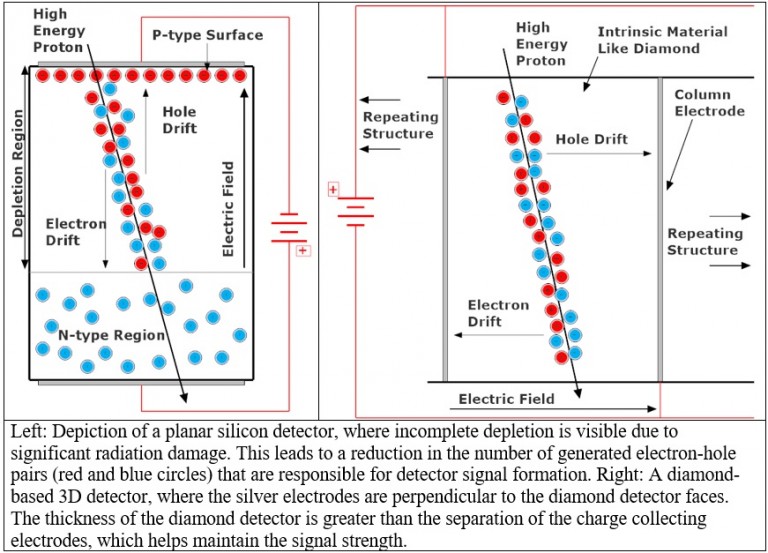
This project investigates the spatial modulation of impinging fast neutron fields using novel moderating structures to localize the neutron source direction using thermal neutron detectors over fast neutron detectors. This enables a higher detection efficiency, simpler readout electronics, and better (or simpler) gamma/neutron discrimination over using pulse shape discrimination techniques with organic scintillators.

Diamond is a unique material due to its low atomic mass, semiconducting properties, and excellent timing resolution of 10 ps. Using multiple diamond detectors, a compact, low power neutron spectrometer/imager is being developed utilizing the concepts of scatter cameras.
A new, novel scintillator has been developed that shows excellent linearity and is very bright (near 100,000 photons per MeV). The growth of this scintillator has shown to be fast, thereby lowering its cost compared to SrI2. The presence of K-40 presents a challenge, so the goal of the project is to determine its the effect of K-40 to its efficacy for both gamma source detection and identification.

High-probability radiological interdiction requires a defense-in-depth strategy, as articulated in Homeland Security’s Global Nuclear Detection Architecture (GNDA). Local search capabilities, including wearable systems, are a critical component of this architecture. Current backpacked-based systems tend to be made from a combination of moderate resolution gamma ray scintillator (NaI(Tl)) and neutron detectors (He-3). A display unit gives the operator some indication of gross gamma and neutron counts for detection and localization, as well as some identification capability based upon the moderate resolution scintillator. Backpacks are more sensitive than the more commonly used handheld detectors (e.g., Identifinder), and they may be used, for example, in searches of city streets, high-rise buildings, or, less commonly, sea-going vessels/ships.
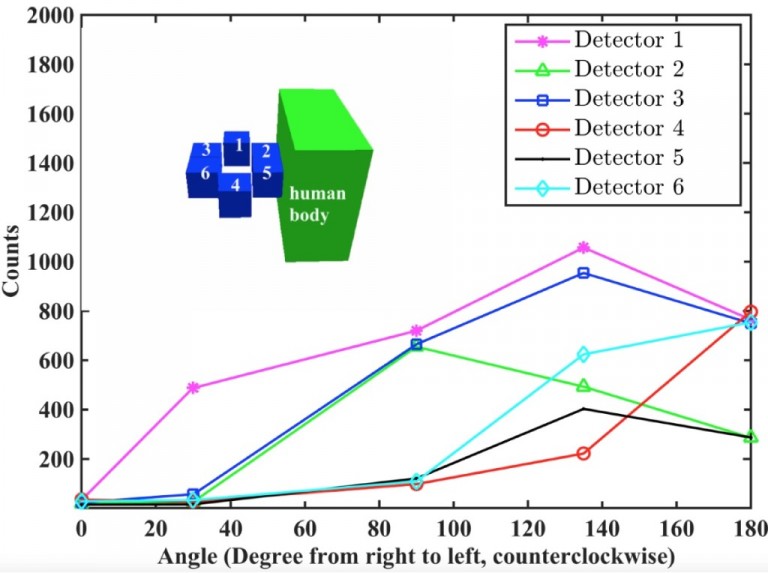
In our IDEAS our WIND program, we will perform basic research investigating the feasibility of different WIND designs that incorporate directionality (as illustrated in figure above for a gamma source located at different angles with respect to a wearer), complex motion sensing, and object/source tracking. A proof-of-concept backpack will be built and demonstrated as a part of government characterizations. The hybrid, modular design will be sensitive to gammas and neutrons, and its design will be simple enough and cost effective to enable widespread deployment. Furthermore, newly developed machine learning algorithms for detection, localization, identification, online tracking, and advanced networking for WIND will be developed under this program, revolutionizing this data-driven application, adding layers of intelligence for robust and superior performance. The proposed work leverages our research experience and infrastructure in mobile RN detection, builds on successes throughout the research community, begins a new partnership with Pacific Northwest National Laboratory (PNNL), and is grounded in expert knowledge of the RN search mission space to ensure that the research conducted here will be academically and operationally impactful.
 In addition to handheld detectors and backpacks, trailer-based RN sensing systems are another important part of the Global Nuclear Detection Architecture. Such larger systems are more sensitive than backpack-based systems, and they may be used for detection and localization of RN threats that may be located tens of meters away from a roadway. Alternatively, they may be placed by the side of the road to function as an advanced portal-less portal monitor– or used for maritime chokepoint monitoring. In the past, trailer-based gamma imaging systems have been investigated and shown to be valuable for detection, localization and source tracking.
In addition to handheld detectors and backpacks, trailer-based RN sensing systems are another important part of the Global Nuclear Detection Architecture. Such larger systems are more sensitive than backpack-based systems, and they may be used for detection and localization of RN threats that may be located tens of meters away from a roadway. Alternatively, they may be placed by the side of the road to function as an advanced portal-less portal monitor– or used for maritime chokepoint monitoring. In the past, trailer-based gamma imaging systems have been investigated and shown to be valuable for detection, localization and source tracking.
Our investigation combines gamma-ray and neutron imaging and spectroscopy system designs in order to improve upon the state-of-the-art in detection and localization of nuclear threat sources at ranges of order 100 m. In particular, this system is sensitive to Pu sources that are shielded by dense materials. A host of first-time innovations were explored through extensive simulations and measurements in order to put together a solution that integrates—for the first time— all available signals from shielded fissile materials. We have also using measurements to investigate systematic fast neutron background variations that are relevant for local area searches. For the first time, we measured systematic fast neutron background variations present in an urban area (downtown Knoxville) in order to understand how this affects our use of detection modalities during mobile search. As a part of this work, we built a trailer-based Dual Detection-Localization-Identification (DLI) proof-of-concept system (see gallery) as a part our Phase V demonstration work. We made measurements with the system while driving past neutron and gamma sources, and the measured data is now being analyzed. This project has been funded by the Department of Homeland Security through Oak Ridge National Laboratory.
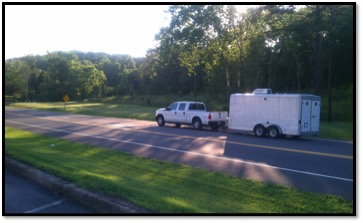
 Scanning-based imaging systems are important for security at airports, ports, border crossings, and also as a part of international arms control and treaty monitoring. Our research group is advancing knowledge and understanding of a new multi-modal imaging technique capable of detecting and determining the properties of shielded HEU assemblies. A simulated result is shown at left, where the location of the fissile material (i.e., HEU) lights up in the tomograph of a complex object that includes gamma (Pb) and neutron (CH2) shielding.
Scanning-based imaging systems are important for security at airports, ports, border crossings, and also as a part of international arms control and treaty monitoring. Our research group is advancing knowledge and understanding of a new multi-modal imaging technique capable of detecting and determining the properties of shielded HEU assemblies. A simulated result is shown at left, where the location of the fissile material (i.e., HEU) lights up in the tomograph of a complex object that includes gamma (Pb) and neutron (CH2) shielding.
Our work has resulted in an increased understanding of the fundamental physics limitations of fast, position-sensitive radiation sensors, with an investigative approach that is tailored to support this application. Our published peer-reviewed papers document this new understanding, which is now being applied to improving system performance parameters, including angular and timing resolution. The research approach includes both experimental and simulation work related to the system as a whole and two associated position-sensitive detectors, one of which is coupled to an interrogating neutron source. It is a multidisciplinary approach, drawing upon expertise in physics, nuclear engineering, electrical engineering, and materials science. The NSF and Homeland Security-funded project leverages recent advances in the medical imaging community as well as infrastructure and expertise at Oak Ridge National Laboratory. It incorporates a substantial amount of international collaboration in its attempt to push the state-of-the-art, and results have been presented at both international and domestic conferences. The UTK team working on this research includes three PhD-seeking students, a senior researcher, and an undergraduate student. Thanks goes to Paul Hausladen at ORNL who did the pilot work on this project, which came before our academic initiative.
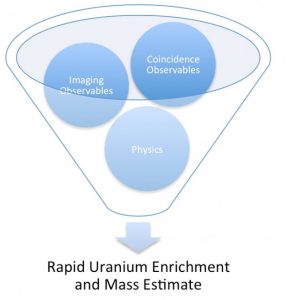 A new project in this same general topic area has been funded by DOE NNSA. This work will focus on the development of new methods that have the potential to rapidly interpret images of uranium assemblies in real-time. Current developed methods utilize Monte Carlo calculations, which are accurate but impractical for use in the field. New methods develop extensions to the point kinetics model and address shielded uranium assemblies. Our work are doing is illustrated at left– imaged observables combined with measured time-correlated neutron data with the appropriate physics are expected to allow us to accurately estimate uranium enrichment and total uranium mass in an assembly.
A new project in this same general topic area has been funded by DOE NNSA. This work will focus on the development of new methods that have the potential to rapidly interpret images of uranium assemblies in real-time. Current developed methods utilize Monte Carlo calculations, which are accurate but impractical for use in the field. New methods develop extensions to the point kinetics model and address shielded uranium assemblies. Our work are doing is illustrated at left– imaged observables combined with measured time-correlated neutron data with the appropriate physics are expected to allow us to accurately estimate uranium enrichment and total uranium mass in an assembly.
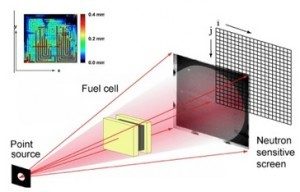 This research topic is highlighted in an internal publication found here.
This research topic is highlighted in an internal publication found here.
Neutron imaging is enabling the discovery of advanced materials for electrodes and electrolytes for the next generation energy storage systems, fuel cell membranes, carbon dioxide sequestration and radiation resistant self-healing. Several areas of research already benefit from neutron imaging, such as engineering, advanced material characterization, fluid-flow and/or two-phase flow devices, automotive technology, advanced manufacturing technology, aerospace, life and biological sciences, and national security applications. Neutrons are specifically well suited for imaging light atoms (e.g., hydrocarbons) buried in heavy atoms, and they are capable of characterizing the dynamics of fluid flow. In spite of all the success that neutron imaging has enjoyed in recent years, even higher-impact research is limited by the current temporal and spatial resolution of neutron detection devices.
In response, our group has been engineering solutions both for gaseous and scintillator-based He-3 replacement technologies in partnership with the Neutron Sciences Directorate at ORNL, and we are also in the midst of early work to help bring about the next generation of higher resolution systems (with goal of 1 micron!) that would impact advanced fuel cell development and diagnosis of cancer.
Our project funded by DOE Basic Energy Sciences is exploiting the recent developments in the area of optoelectronics with a goal to investigate and develop new concepts for position sensitive area detectors with orders of magnitude higher spatial resolution and higher temporal resolution and to demonstrate its capability to map the Li distribution in an operating Li-air cell (an important goal for our partner Hassina Bilheux at ORNL). Success in this research will be transformational to the field of neutron imaging and mesoscale science. It will also usher in faster detectors for energy selective imaging that would be possible at the high intensity pulsed neutron sources such as the Spallation Neutron Source, where VENUS, an imaging instrument, is being built for the worldwide scientific community. VENUS is due to be completed in three and a half years. The processes, knowledge and algorithms developed will allow for spatially (1 micron) and time resolved (~100 ns) high throughput neutron transmission imaging in large areas at reasonable costs in the near term. In addition to benefiting neutron imaging, these detectors will greatly benefit single crystal Laue diffraction for macromolecular research.